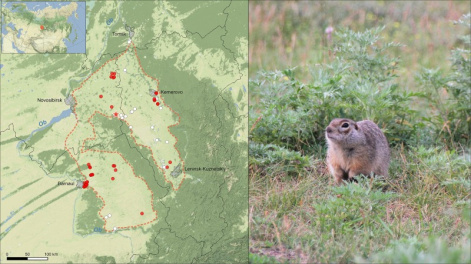Scientists have revised the evolution of ground squirrels in Eurasia and discovered a new species
28 March 2024 г. FRC KSC SB RAS

Ground squirrels are an important and diverse part of Eurasian ecosystems. Their traditional classification is primarily based on morphological traits and geographic range. However, this classification was incomplete and imprecise.
A team of Russian scientists, including a researcher from the Federal Research Center "Krasnoyarsk Science Center SB RAS", for the first time reconstructed the evolutionary history of Palaearctic ground squirrels and discovered a new species unique to Western Siberia. To do this, they conducted a study using complex molecular phylogenetic analysis with additional support from morphological and genomic data.
It turns out that ancient ground squirrels split from a common ancestor into four main groups about 6.2 million years ago. One of them includes species from East Asia, the second - from Eastern Europe and north-west Central Asia, the third - from Central and Eastern Europe, and Asia Minor. The fourth group is formed by ground squirrels, living in Central Asia and neighboring regions. Thus, Eurasian ground squirrels turn out to be more ancient than previously thought, based on excavation data.
Experts also discovered and described a new species of ground squirrel from Western Siberia. It is distinguished by its darker color and large size, and other physical features. The new species is distributed between the eastern bank of the Ob River and the western slopes of the Kuznetsk Alatau. Scientists note that this is one of the smallest ranges among Eurasian ground squirrels with very small numbers. Experts also drew attention to the fact that since the end of the 20th century in Siberia there has been a sharp decline in the numbers of all ground squirrel populations: some of them are even listed in the Red Data Books of the regions and are in danger of extinction.
The results obtained complement and clarify previous studies. Scientists note that the data obtained helps to better understand the evolutionary relationships between ground squirrel species and can serve as a basis for developing strategies for the conservation and control of populations of these animals.
“Our results have important implications for the classification and taxonomy of ground squirrels. We propose to revise the taxonomic classification of the genus Spermophilus, recognizing 18 species, including the recently identified one (S. vorontsovi sp. nov.), which occurs only in a limited area in the southeast of Western Siberia. Using genome-wide single nucleotide polymorphism genotyping, we have substantiated the role of the Ob River as the main barrier ensuring reliable isolation of this taxon from S. erythrogenys. These results represent a significant advance in the study of ground squirrel diversity and highlight the importance of using genetic methods for animal taxonomy. They can help in understanding the evolution and development of these animals, as well as in their conservation,” said a co-author of the study Natalya Oreshkova, senior researcher, head of the Laboratory of genomic research and biotechnology of the Federal Research Center KSC SB RAS.
The study was supported by the Russian Science Foundation No. 22-24-00913.
Scientists from the Institute of Systematics and Animal Ecology of SB RAS also took part in the study as well as researchers from the V.A. Engelhardt Institute of Molecular Biology of RAS; N.K. Koltsov Institute of Developmental Biology of RAS; National Medical Research Center for Hematology; Zoological Institute of RAS and Penza State University.
Share:
